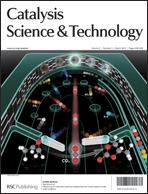Hydrogen-assisted CO dissociation on the Co(211) stepped surface†
Abstract
In the Fischer–Tropsch synthesis (FT) process the mechanism of CO dissociation is of fundamental importance. In this study we compare hydrogen-assisted CO dissociation mechanisms to direct CO dissociation on the B5 site as exposed on the fcc-Co(211) surface. Whereas direct CO dissociation is calculated to have an overall barrier of 142 kJ mol−1, the alternative mechanism involving a HCO intermediate proceeds with a lower overall barrier of 123 kJ mol−1. Using these calculated values we show that hydrogen-assisted CO dissociation will result in an overall rate corresponding to the same order as the considered FT experiments.


 Please wait while we load your content...
Please wait while we load your content...